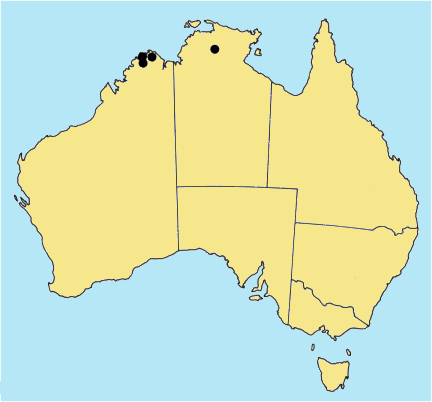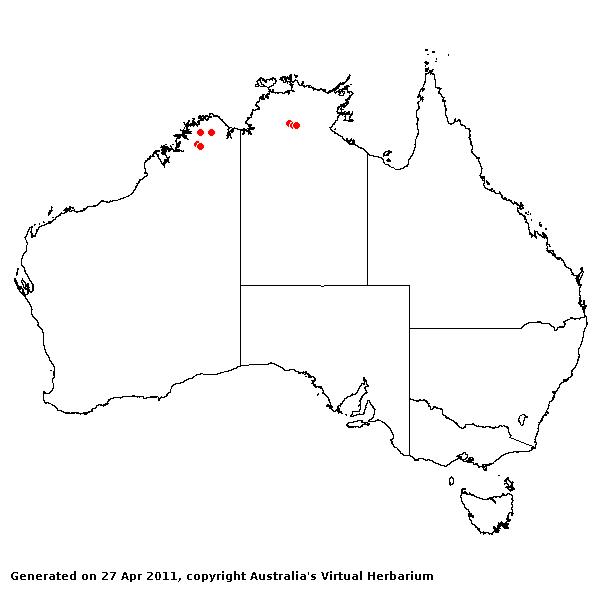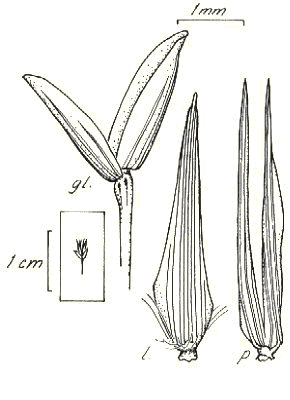Eriachne glandulosa M. Lazarides. Austral. Syst. Bot. 8: 384 (1995).
Classification. (GPWG 2001) : Subfamily Micrairoideae. Eriachneae.
Type of Basionym or
Protologue Information: Australia, Mitchell Plateau: Kenneally 8006 (CANB holo, PERTH).
Key references (books
and floras): [2002] D.Sharp & B.K.Simon, AusGrass, Grasses of
Australia.
Illustrations:
[2005] K.Mallet (ed.), Flora of Australia 44B: Poaceae 3 (Fig.
25K-M).
Habit.
Perennial. Culms erect, 10–30 cm tall, 3 -noded. Mid-culm internodes glabrous.
Mid-culm nodes glabrous. Lateral branches simple. Leaves mostly basal.
Leaf-sheaths glabrous on surface or hairy. Ligule a fringe of hairs, 1 mm long.
Leaf-blades erect, flat or involute or convolute, 5–14.5 cm long, 2–3.3 mm
wide. Leaf-blade surface scabrous, glabrous or indumented.
Inflorescence.
Inflorescence compound, a panicle. Panicle ovate, 2.5–6 cm long, 2.5–4 cm wide.
Spikelets.
Spikelets pedicelled. Fertile spikelets 2-flowered, both fertile, comprising 2
fertile floret(s), without rachilla extension, ovate, laterally compressed,
2.5–3.3 mm long.
Glumes.
Glumes similar, thinner than fertile lemma. Lower glume ovate, membranous, much
thinner on margins, without keels, 3–5 -nerved. Lower glume surface glabrous.
Lower glume apex muticous or mucronate. Upper glume ovate, 1.6–2 mm long,
membranous, without keels, 3–5 -nerved. Upper glume surface smooth, glabrous.
Upper glume apex muticous or mucronate.
Florets.
Fertile lemma 2.5–3.3 mm long, without keel, 7 -nerved. Lemma surface
indumented. Lemma apex muticous. Palea 2 -nerved. Palea apex entire or dentate,
muticous. Lodicules present. Anthers 3. Grain 1.5–1.7 mm long.
Continental
Distribution: Australasia.
Australian
Distribution: Western Australia, Northern Territory.
Western Australia:
Gardner. Northern Territory: Darwin & Gulf.
Notes.
The glandular panicle, florets longer than glumes and thickened compactly
fibrous base are diagnostic characters. The presence of glands is a unique
condition in the genus. The basal fibres, representing the remains of the old,
persistent sheaths, combine with the fibrous roots and regenerating tillers to
form a dense mass. Other distinctive features include glabrous simple grooved
few-noded culms, thickly nerved often scabrous-tubercled leaves, open exserted
panicle, awnless spikelets, glabrous small glumes relative to florets,
membranous to hyaline finally divergent sparsely hairy lemma and palea, and
palea which may split between the keels with maturity. The floret resembles
that of E. bleeseri, but this species has shortly awned lemmas, much
larger spikelets, and differs in habit and other features. Both species appear
to be isolated in their individual relationships.
Endemic.
N of 15ºS and W of Long. 133ºE in N.T. and W.A. Growing in skeletal sand over
massive pavements of sandstone and basalt, or amongst granite boulders, often
in shallow pools or seepage. Flowers Dec.-Feb. (summer).



